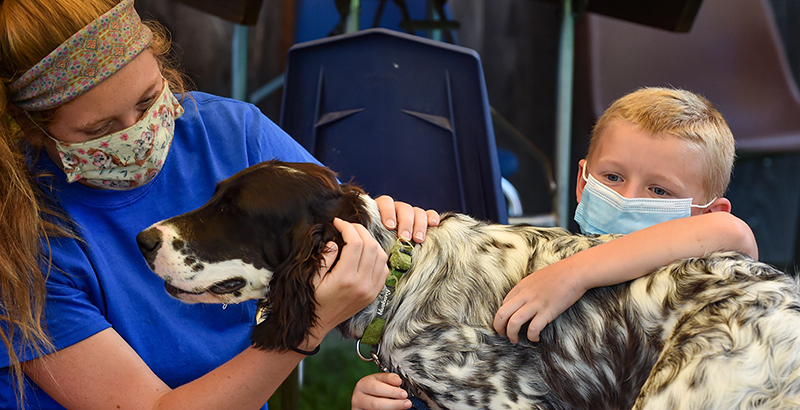The Emotional Power of Pets: As Classrooms Reopen, Why Schools Should Also Save a Place for Therapy Animals

Get essential education news and commentary delivered straight to your inbox. Sign up here for The 74’s daily newsletter.
Education experts are proposing myriad interventions to address the harm the pandemic is having on students’ academic progress and social-emotional well-being. National tutoring programs. More school counselors. Year-round school.
But scientific research and findings from a new market research survey of 2,000 parents align with an idea already backed by decades of robust research: give pets a place in schools.
Yes, pets.
Children have suffered as the pandemic forced school buildings to close and public health experts to discourage in-person interaction. According to a report from Save the Children, more than half of children who were separated from their friends during the pandemic feel less happy and more worried as a result.
Pets have provided relief while many students have been adjusting to suddenly learning from home. The number of pets in U.S. homes surged during the first year of the pandemic, while dogs in foster care increased by 17 percent and cats by 23 percent, compared to 2019.
And, according to that market research survey of 2,000 parents in the United States and United Kingdom who own pets and have school-age children, pets had a remarkable effect. Results show 83 percent of parents believe a pet helped their child feel less lonely, and 73 percent felt their pet reduced stress caused by isolation away from classmates. Overall, 9 in 10 believe their pet has positively impacted their child’s experience with remote education and more than half (56 percent) report having a pet helped improve their child’s academic performance and motivation for virtual schoolwork.
Robust research backs these parents’ view. In her role as Vice President at the Waltham Petcare Science Institute, Kay has worked with global partners for over 10 years exploring human animal interaction in settings from classrooms to hospitals and at work or at home. Research published in 2020 in partnership with the National Institutes of Health (NIH) found that having animals in the classroom can have a positive impact on learning by directly increasing motivation, engagement, self-regulation, and human social interaction.
Previous studies have shown that children with pets have higher levels of self-esteem than children without pets and dogs in particular can help children cope with attention-deficit-hyperactivity disorder (ADHD). And research conducted by Washington State University with support from Waltham also found that therapy dogs can help boost college students’ attention and memory and help them tackle stress, and a similar study at Kent State University showed dogs can help younger students relieve stress, too.
Now, as school buildings reopen around the world, the vast majority of parents surveyed — 80 percent — would like their child to be able to continue realizing these benefits as they return to school, too.
To be clear, we are not suggesting schools allow all students to bring their family pets to school. We are also mindful of the need to properly train animal therapy teams and provide education for students on how to appropriately interact with pets to ensure the well-being of all involved.
In other words, we are advocating for intentional pet interaction in schools, which would expand opportunities for children to benefit from animal interaction beyond just those fortunate to have pets at home.
Pet Partners, where Mary Margaret is the Chief Mission Officer, has been supporting schools, hospitals, and other organizations with animal-assisted interventions since 1990 and pivoted to offer this service virtually last year. During the pandemic, her team has been inundated with interest from teachers, parents, and students for virtual therapy animal visits.
The timing couldn’t be better.
Over the last year, a consistent majority of parents of public school students have supported rethinking what education looks like after the pandemic, and the infusion of financial support from the federal government has schools searching for ways to spend this new funding. According to the market research survey we mentioned earlier, three-quarters of parents support schools investing more to bring intentional pet interaction into the traditional classroom setting.
The idea is more feasible than you might imagine. Before the pandemic, many schools, including dozens in New York City, were using emotional support animals with positive results. Many businesses embraced the idea, too. Pre-pandemic, highly sought-after employers like Amazon, Uber, and Airbnb were welcoming thousands of pets into their offices, with the rationale that the perk attracted employees and, ultimately, improved performance.
Admittedly, welcoming therapy animals into schools is still considered a nontraditional idea. But, as we embrace the “new normal” in all aspects of life post-pandemic, maybe now is the time to reflect on what we learned and look at unconventional ideas.
Dr. Kay O’Donnell is the Vice President of the Waltham Petcare Science Institute, the science center for Mars Petcare focused on advancing research into the nutrition and health of pets. Mary Margaret Callahan is the Chief Mission Officer of Pet Partners, the leading organization in the United States offering trained therapy animal interaction programs.
Get stories like these delivered straight to your inbox. Sign up for The 74 Newsletter

;)